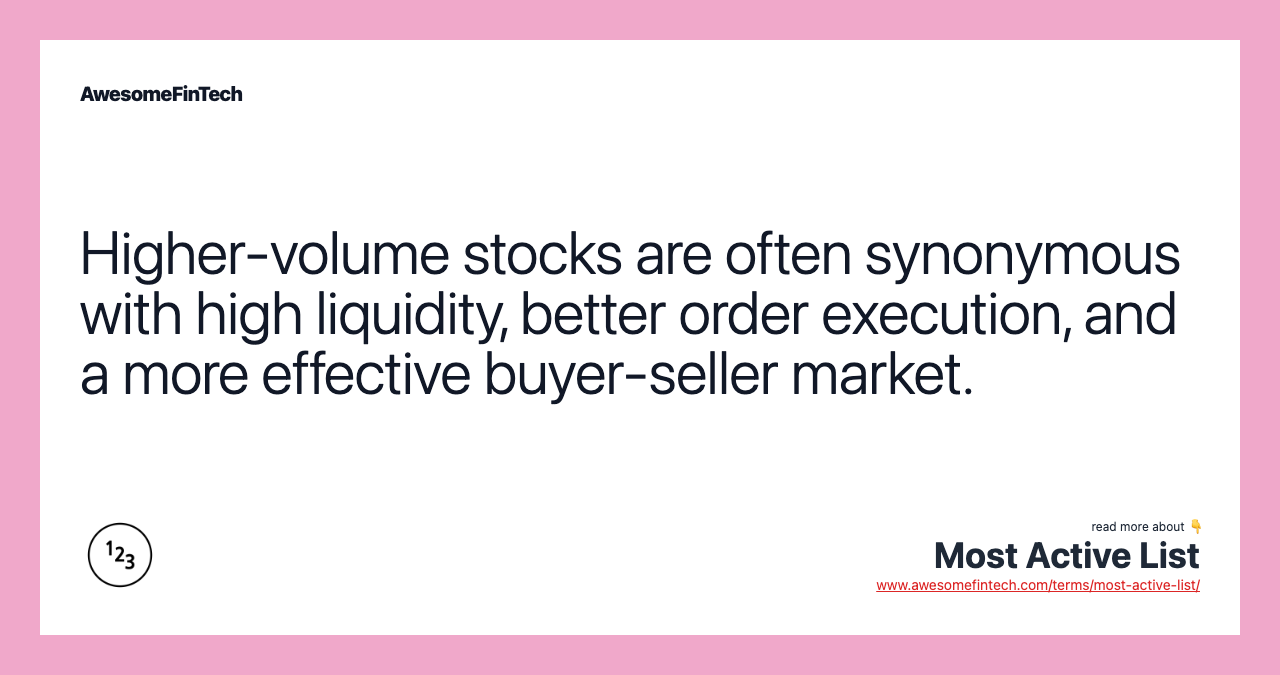Most Active List
A most active list is a listing of stocks with the highest trading volumes on a specific exchange over a defined period, generally one day. Higher-volume stocks are often synonymous with high liquidity, better order execution, and a more effective buyer-seller market. The most active list can include stocks that have had both positive or negative price changes and sometimes can even include stocks with an overall price change that has been close to zero. The volume of trade measures the total number of shares that have been transacted for a specific security during a specific time period, with higher trade volumes for securities generally signifying higher liquidity, better order execution, and a more active market for connecting buyers and sellers. Often, these lists will include further details and categorization, such as lists of most active stocks by share volume and most active by dollar volume. In a bull market, the majority of the stocks on the most active list will have positive price changes, although there will be some trading lower, perhaps due to company or sector-specific news.

What Is a Most Active List?
A most active list is a listing of stocks with the highest trading volumes on a specific exchange over a defined period, generally one day. The volume of trade measures the total number of shares that have been transacted for a specific security during a specific time period, with higher trade volumes for securities generally signifying higher liquidity, better order execution, and a more active market for connecting buyers and sellers.





How a Most Active List Works
The most active list can include stocks that have had both positive or negative price changes and sometimes can even include stocks with an overall price change that has been close to zero.
In a bull market, the majority of the stocks on the most active list will have positive price changes, although there will be some trading lower, perhaps due to company or sector-specific news. On the other hand, in a bear market, the most active list will mostly include stocks with negative price changes; however, there will be occasional standouts to the upside, especially defensive plays.
Indexes and exchanges usually have a list of their most active stocks for the day as well as their most declined stocks for the day. These lists have other nicknames as well, such as winners and losers or hot and cold stocks. Often, these lists will include further details and categorization, such as lists of most active stocks by share volume and most active by dollar volume.
Financial analysts will sometimes compile daily data from most active lists into monthly or yearly reports, which list the highest-traded stocks over the course of that period of time.
Reasons for Appearing on a Most Active List
The most active lists in the U.S. and Canada generally are made up of the most widely followed stocks on their benchmark indexes, such as the Dow Jones Industrial Average and S&P 500 in the U.S. and the TSX/S&P Composite Index in Canada.
Sometimes, when companies have some important information released, such as quarterly results, this will result in higher-than-usual trading volumes and an appearance on the most active list.
During the quarterly reporting period, unfamiliar names can appear on the most active list. This is often because these stocks have either exceeded or missed earnings estimates, which results in higher than usual trading volumes.
Market analysts turn to the most active list and information it provides about trade volume to help them determine whether a market is in bull or bear mode.
Related terms:
Active Stocks
Active stocks are heavily traded stocks on an exchange with lower bid-ask spreads and higher liquidity. read more
Canadian Securities Exchange (CSE)
The Canadian Securities Exchange (CSE), formerly Canada’s New Stock Exchange, is an electronic stock exchange for small-cap, microcap, and emerging companies in Canada. read more
Correction
A correction is a drop of at least 10% in the price of a stock, bond, commodity, or index. read more
Most Active and Example
Most active refers to stocks on an exchange that trade the highest volume of shares over a given period. read more
S&P/TSX Composite Index
The S&P/TSX Composite Index is a capitalization-weighted index that tracks the performance of companies listed on the Toronto Stock Exchange (TSX). read more
TSX Venture Exchange
TSX Venture Exchange is a stock exchange in Canada that was originally called the Canadian Venture Exchange (CDNX). read more
Volume of Trade
The volume of trade is the total quantity of shares or contracts traded for a specified security during a set period of time. read more